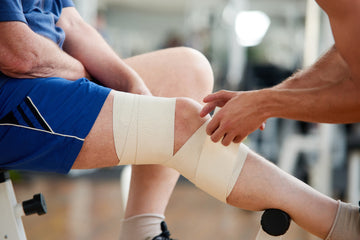You probably already know that running is a great way to stay fit and is great for maintaining your health – but did you know there is more than one type of running you can participate in? Two popular options for running include trail running and road running, both of which have their own unique characteristics and benefits. In this article, you will:
- Learn the differences between road running vs trail running
- Learn the benefits and challenges of both styles of running
- Find out what gear is needed for trail running and road running
- Learn how easy it is to get started
- Find out how mentally and physically advantageous running is for the mind and body
Trail Running vs Road Running: Critical Differences
There are some critical differences between trail running vs road running – including how they are done and the benefits they provide the runner. These types of running differ significantly in terms of terrain, surface, and overall experience.
Road running typically occurs on paved surfaces like sidewalks, streets, or tracks, while trail running involves off-road paths, often through natural environments like forests, mountains, or parks. Even the uneven terrain and varied surfaces of trails require different skills and techniques compared to the smooth and predictable surfaces of roads.
Benefits & Challenges of Road Running vs Trail Running
Whether you choose to run on the road or on a trail, understanding the unique benefits and challenges each one poses can be both beneficial and exhilarating to a new or avid runner.
Benefits of road running include:
- Easier to track performance and set goals
- Less route planning required
- Ability to run faster, for longer, to build endurance
- Convenience, safety and accessibility
Benefits of trail running include:
- An immersive experience with nature
- Engaging a broader range of muscles
- Lower impact and easier on the joints/muscles
- Upper body workout as well vs only lower body
Both types of running provide these benefits:
- Improved cardiovascular health
- Increase in bone density
- Reduction in stress levels
There are also different challenges when it comes to road running vs trailing running.
Challenges of road running include:
- Higher impact on joints and muscles
- Air pollution from car exhausts
- Potential obstacles with pedestrians and traffic
Challenges of trail running include:
- More difficult than road running
- New terrains that pose physical challenges
- Risk of injuries to knees, feet, and muscles
- Blisters from improper footwear
Alongside the physical challenges and benefits of running, there’s also an increased sense of self-accomplishment and mental health benefits no matter the terrain.
Physical & Mental Health Benefits of Road Running vs Trail Running
Runners can get significant mental and physical benefits from running, whether on a trail or a flat road surface. Known as ‘runner’s high,’ there is proof that physical activity is good for both the mind and the body. Running, in general, creates a calming and stress-relieving experience. Some of the physical and mental health benefits include:
- Trail running creates a personal connection with nature for stress relief
- Trail running helps improve balance and enhance proprioception
- Road running allows for consistency in training
- Road running offers opportunities for social interaction
- Both contribute to a higher sense of accomplishment, cardiovascular fitness and mental clarity.
How to Start Trail Running vs Road Running
Even if you’re new to running, you can get started relatively easily and take the first step towards building a healthier lifestyle.
To get started:
- Research the areas you plan to run
- Consider distance, elevation, and level of difficulty
- Determine the style of running you wish to pursue
- Select the right gear
- Decide the time of day that works best for you to run
- Create your routine
Is it better to start with trail running, or road running? Only you can figure out what your personal running taste is - if you enjoy heading out into unmapped areas and running for the thrill of discovery, trail running might be right for you. If you prefer well-known locations and don’t look for the thrill of unknown territories, road running might be precisely what you need.
Gear Needed for Trail or Road Running
The choice of gear is crucial for both trail running and road running.
Having the right shoes can help reduce the amount of leg soreness you might feel after a run. Road runners typically require lightweight, cushioned shoes optimized for impact absorption on hard surfaces. Trail runners, however, benefit from shoes with aggressive tread patterns and enhanced stability to navigate uneven terrain effectively.
In addition to proper footwear, trail runners should consider wearing moisture-wicking clothing, a hydration pack or belt, and potentially trail-specific accessories such as gaiters to keep debris out of their shoes. Both sets of runners should have access to a first-aid kit while running in case they take a tumble.
Recovery for Trail Running vs Road Running
At the end of every run, everyone needs to take time to recover so strains and sprains don’t occur on the next run. Since running causes exertion on the body, it needs proper time to recuperate before the next run no matter what type of running you choose.
Trail running, with its varied terrain and increased impact on muscles and joints, may require more focus on recovery than road running.
Recovering from running includes:
- Adequate rest
- Proper nutrition
- Cross-training activities like yoga or swimming can help reduce the risk of and prevent running injuries.
- Recovery tools such as massage chairs, which can help relax muscles and alleviate soreness.
Your recovery routine doesn’t have to be elaborate or time consuming. Even something as simple as enjoying the right post-run massage can make a difference when planning your journey with trail running vs road running.
Time to Get Started Running
Choosing to start running is a powerful choice to maintain and improve your overall health. Whether you choose to start with trail running or road running, make sure you stretch, have the right equipment, and block out ample time for self-care and recover.
Above everything else, have fun. Once you do that, there's no wrong way to enjoy a run.





